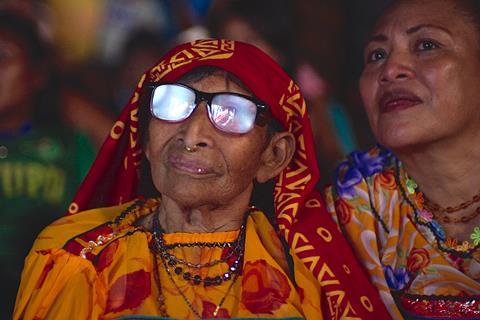Panama’s indigenous Kuna fight to reclaim a documentary filmed in their community in 1975

Dir: Andres Peyot. France/Switzerland/Panama. 2023. 85min
In 1975, Oscar-winning French documentarian Pierre Dominique Gaisseau (The Sky Above, The Mud Below) travelled to Panama, ostensibly to make a film about the indigenous island-dwelling Kuna people. He, his wife and young daughter lived with the community, filming all aspects of their life — with the promise that the finished documentary would belong to them. Yet, 50 years on, they were still fighting to see it. Swiss-Panamanian director Andres Peyot uncovers the fascinating story behind the film and, along the way, raises essential questions about the West’s treatment of indigenous people and the cultural impact of documentary filmmaking itself.
Raises essential questions about the West’s treatment of indigenous people and the cultural impact of documentary filmmaking itself
God Is A Woman has been ten years in the making – Peyot, who is not Kuna, first became aware of this story after meeting local film director Orgun at a film festival in 2010 and stepped in to the story; another outsider, it could be argued, but at least one who is closer to their home. The film opens Venice Critics Week before heading to Toronto, and should pique further festival interest. Beyond, a curated streamer could prove a comfortable fit.
For today’s Kuna, Gaisseau’s filming looms large in the collective memory. Elders recall their involvement with clarity; one woman is full of pride as she speaks of how her then-infant daughter’s initiation ceremony was captured on camera. (Her daughter, now in her 50s, has not lived in the village for over 20 years). A respected elder, Turpana, (who sadly died of Covid-19 in 2020) was a young man when he appeared in the film, and talks with fondness about time spent with Gaisseau, his wife Kyoko and two year old daughter Akiko.
But this remains a tight-knit community — the fact that they still refer to Gaisseau as “the foreigner” says as much — and there is a shared sadness that they never saw the finished film; when the production fell into financial difficulty, the film was seized by funders. On the surface, it is upsetting that they have not had the opportunity to see loved ones who have long since passed. But their frustrations run deeper. Who else has the right to own their experiences, they argue, but themselves; particularly at a time when their community is walking a challenging line between tradition and progress.
Two reels of the film were finally discovered in the basement of Panama’s Ministry Of Culture, only to have disintegrated beyond repair. This is one of many moments that speak volumes about the lack of respect for indigenous people; its to Peyot’s credits that he never feels the need to over-egg these moments. Throughout, the music largely remains restrained while camera-work is similarly matter-of-fact, aside from a few artistic flourishes such as the layering of images.
This approach keeps the focus on the Kuna, maintains an authenticity that was not so present in Gaisseau’s film. His assertation that the community viewed women as sacred leaders (hence his film’s title, shared by Peyot) turns out to be somewhat misplaced; they believe in the balance between masculine and feminine. And those who participated in the film recall how Gaisseau would balk at any hint of modernity, and refuse to put anything on camera that didn not subscribe to a romanticised view of indigenous life. The Kuna remain frustrated by this Western opinion that indigenous people represent a simplistic ideal.
In sharp contrast, Peyot showcases the Kuna as they are; village life may still be basic by Western standards, but mobile phones allow contact with relatives who have moved to the city. Technology has also allowed locals, like youngsters Orgun and Duiren, to pick up a camera and make their own content, including a music video for a local rap artist. Unlike Gaisseau, Perot also captures a ceremony in which locals recreate the Revolution of 1925, when Panama gained its independence from Colombia.
And when a copy of the finished film is found in a Paris basement with the help of Gaisseau’s daughter Akiko (who died in 2021), Orgun and Duiren are on hand to help with its triumphant return. When the village gathers together to watch the crackling film, on a screen made from a sheet hung between posts, it is a moment of bittersweet joy, This is, for the Kuna, not about wider recognition, but something far more important — a celebration of, and educational tool for, their own people; a cultural moment which belongs entirely to them.
Production companies: Industrie Films, Upside Films
Internationals Sales: Pyramide
Producers: Brieuc Derano, Andres Peyrot, Johan De Faria, Sebastian Deurdilly, Benedicte Perrot
Screenplay: Andres Peyrot, Elizabeth Wautlet
Cinematography: Patrick Tresch, Nicolas Desaintquentin
Editor: Sabine Emiliani
Music: Gregoire Auger
























